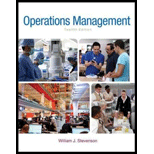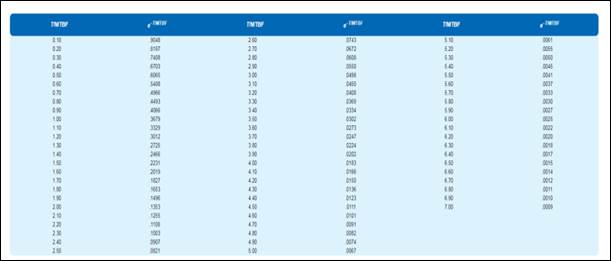
An electronic chess game has a useful life that is exponential with a mean of 30 month. Determine each of the following:
a. The probability that any given unit will operate for at least (1) 39 months. (2) 48 men the (3) 60 months.
b. The probability that any given unit will fail sooner than (1) 33 months. (2) 15 months. (3) 6 months.
c. The length of service tune after which the percentage of tilled units will approximately equal (1) 50 percent, (2) 85 percent, (3) 95 percent, (4) 99 percent.
a)
To determine: The probability the unit will operate at least for the following times.
Introduction:
Mean time between failures (MTBF):
The mean time between failures is a term which denotes the time that is elapsed between the first failure of a product and the second failure of a product. It is calculated during the normal system operation.
Answer to Problem 12P
1) 39 months = 0.2725
2) 48 months = 0.2019
3) 60 months = 0.1353
Explanation of Solution
Given information:
MTBF = 30 months
Formula to calculate the probability of no failure before a time period:
Calculation of probability:
1) 39 months:
Hence, the probability the unit will operate at least for the 39 months is 0.2725.
2) 48 months:
Hence, the probability the unit will operate at least for the 48 months is 0.2019.
3) 60 months:
Hence, the probability the unit will operate at least for the 60 months is 0.1353.
b)
To determine: The probability the unit will fail before the following times.
Introduction:
Mean time between failures (MTBF):
The mean time between failures is a term which denotes the time that is elapsed between the first failure of a product and the second failure of a product. It is calculated during the normal system operation.
Answer to Problem 12P
1) 33 months = 0.6671
2) 15 months = 0.3935
3) 6 months = 0.1813
Explanation of Solution
Given information:
MTBF = 30 months
Formula to calculate the probability of failure before a time period:
Calculation of probability:
1) 33 months:
Hence, the probability the unit will fail before 33 months is 0.6671.
2) 15 months:
Hence, the probability the unit will fail before 15 months is 0.3935.
3) 6 months:
Hence, the probability the unit will fail before 6 months is 0.1813.
c)
To determine: The length of service time for the percentage of failed units.
Introduction:
Mean time between failures (MTBF):
The mean time between failures is a term which denotes the time that is elapsed between the first failure of a product and the second failure of a product. It is calculated during the normal system operation.
Answer to Problem 12P
1) 50 percent = 21 months.
2) 85 percent = 57 months.
3) 95 percent = 90 months.
4) 99 percent = 138 months.
Explanation of Solution
Given information:
MTBF = 30 months
Formula to calculate the probability of no failure before a time period:
Calculation of probability:

The different probabilities are obtained from the above table.
1) 50 percent:
From the table for the value of 0.50 is equivalent to:
Therefore,
Hence, the length of service time for the percentage of failed units is 21 months.
2) 85 percent:
From the table for the value of 0.15 is equivalent to:
Therefore,
Hence, the length of service time for the percentage of failed units is 57 months.
3) 95 percent:
From the table for the value of 0.05 is equivalent to:
Therefore,
Hence, the length of service time for the percentage of failed units is 90 months.
4) 99 percent:
From the table for the value of 0.01 is equivalent to:
Therefore,
Hence, the length of service time for the percentage of failed units is 138 months.
Want to see more full solutions like this?
Chapter 4 Solutions
Operations Management (McGraw-Hill Series in Operations and Decision Sciences)
- A local cab company maintains a fleet of 10 cabs. Each time a cab breaks down, it isrepaired the same day. Assume that breakdowns of individual cabs occur completely atrandom at a rate of two per year.d. What is the probability that there are more than five breakdowns between Thanksgiving Day (November 28) and New Year’s Day (January 1)?e. For what reason might your answer in part (d) be too low?arrow_forwardA weather satellite has an expected life of 10 years from the time it is placed into earth orbit. Determine its probability of no wear-out before each of the following lengths of service. Assume theexponential distribution is appropriate.a. 5 years b. 12 years c. 20 years d. 30 yearsarrow_forwardThe assumption that a system will operate in a stable environment without risk is not realistic (Sales et al., 2018). Risk is widely classified into disruption and operational risks (Kleindorfer & Saad, 2005; Tang, 2006). Extreme uncertainty and the absence of synchronization between supply and demand are linked to operational risks while circumstances such as labor strikes, terrorist attacks, and natural calamities are related to disruption risks (Lockamy & McCormack, 2010). The probability of human injury or even death is high in disruptions such as multi-casualty disasters which brings about the challenge of increased pressure on healthcare. Healthcare institutions are required to become capable of understanding and adapting to environmental changes to mitigate such unexpected changes. These unexpected changes can affect the competitiveness, responsiveness and operating procedures of a firm significantly (Huang, Yen, & Liu, 2014), and for healthcare institutions, the…arrow_forward
- A product engineer has developed the following equation for the cost of a system component: C = (10P) 2, where C is the cost in dollars and P is the probability that the component will operate as expected. The system is composed of two identical components, both of which must operate forthe system to operate. The engineer can spend $173 for the two components. To the nearest two decimal places, what is the largest component probability that can be achieved?arrow_forwardThe mean repair time of a reproduction machine every time it becomes defective is 5 hours, and is assumed to be available 95% of the time. What is its mean time between failure (MTBF)?arrow_forwardThe annual maintenance costs of a machine that has been in use for 3 years are 300 TL, 350 TL and 375 TL, respectively. The machine is expected to be available for 8 years after purchase. The maintenance costs foreseen for the coming years are 400 TL in the first year and 150 TL in the following years. If the machine is sold today, it can be sold for 1500 TL, and in the following years for 1000 TL. What is the optimum regeneration time of the machine if the MCVO is 10%?arrow_forward
- A local cab company maintains a fleet of 10 cabs. Each time a cab breaks down, it isrepaired the same day. Assume that breakdowns of individual cabs occur completely atrandom at a rate of two per year.a. What is the probability that any particular cab will run for a full year withoutsuffering a breakdown?arrow_forwardA product engineer has developed the following equation for the cost of a system component: C = (10P)2, where C is the cost in dollars and P is the probability that the component will operate as expected. The system is composed of 3 identical components, all of which must operate for the system to operate. The engineer can spend $254 for the 3 components. What is the largest component probability that can be achieved? (Do not round your intermediate calculations. Round your final answer to 4 decimal places.) Probability 0.8466arrow_forwardThe school of business has 3 fax machines. The toner in each machine needs to be changed after about 5 hours of use. There is one unit secretary who is responsible for the fax machine maintenance. It takes him 15 minutes to replace the toner cartridge. What is the probability the system is empty?arrow_forward
- A company owns a 5-year-old turret lathe that has a book value of $23,000. The present market value for the lathe is $18,000. The expected decline in market value is $1,700/year to a minimum market value of $4,080; maintenance plus operating costs for the lathe equal $4,470/year.A new turret lathe can be purchased for $46,000 and will have an expected life of 8 years. The market value for the turret lathe is expected to equal $46,000(0.70)k at the end of year k. Annual maintenance and operating cost is expected to equal $1,900. Based on a 12% MARR, should the old lathe be replaced now? Use an equivalent uniform annual cost comparison, a planning horizon of 7 years, and the cash flow approach.EUAC for keeping old turret lathe: $EUAC for replacing turret lathe: $arrow_forwarda buliding owned by hopewell company was recently valued at 850,00 by a real estate expert , the president of the company is questioning the accuracy of the firms latest balance sheet becuase it shows a book value of 550,000 for the building ,how would you explain a situation to the president.arrow_forwardAt the beginning of each week, a machine is in one of four conditions: 1 = excellent; 2 = good; 3 = average; 4 = bad. The weekly revenue earned by a machine in state 1, 2, 3, or 4 is 100, 90, 50, or 10, respectively. After observing the condition of the machine at the beginning of the week, the company has the option, for a cost of 200, of instantaneously replacing the machine with an excellent machine. The quality of the machine deteriorates over time, as shown in the file P10 41.xlsx. Four maintenance policies are under consideration: Policy 1: Never replace a machine. Policy 2: Immediately replace a bad machine. Policy 3: Immediately replace a bad or average machine. Policy 4: Immediately replace a bad, average, or good machine. Simulate each of these policies for 50 weeks (using at least 250 iterations each) to determine the policy that maximizes expected weekly profit. Assume that the machine at the beginning of week 1 is excellent.arrow_forward
 Practical Management ScienceOperations ManagementISBN:9781337406659Author:WINSTON, Wayne L.Publisher:Cengage,
Practical Management ScienceOperations ManagementISBN:9781337406659Author:WINSTON, Wayne L.Publisher:Cengage,
